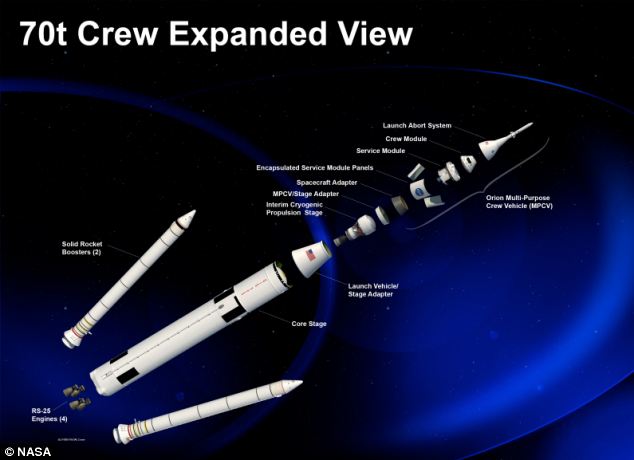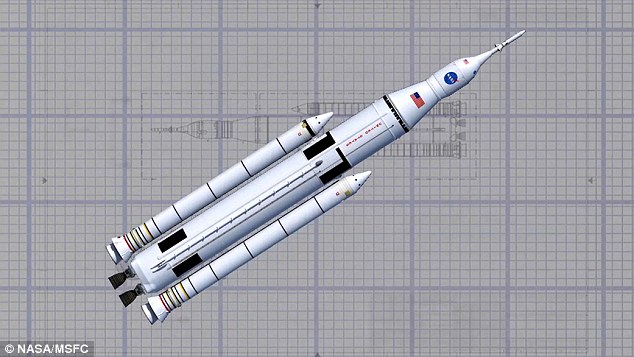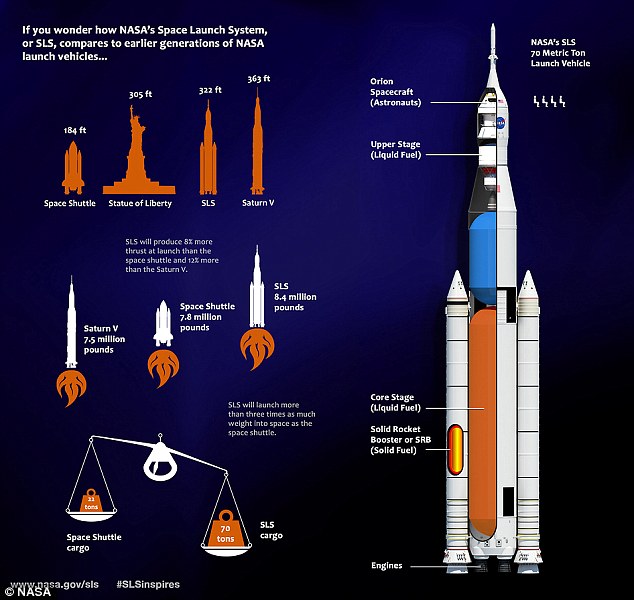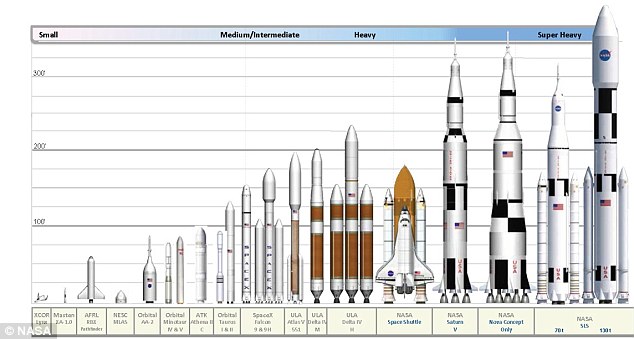CAPSLOCKSTUCK
Spaced Out Lunar Tick
- Joined
- Feb 26, 2013
- Messages
- 8,578 (1.90/day)
- Location
- llaregguB...WALES
| System Name | Party On |
|---|---|
| Processor | Xeon w 3520 |
| Motherboard | DFI Lanparty |
| Cooling | Big tower thing |
| Memory | 6 gb Ballistix Tracer |
| Video Card(s) | HD 7970 |
| Case | a plank of wood |
| Audio Device(s) | seperate amp and 6 big speakers |
| Power Supply | Corsair |
| Mouse | cheap |
| Keyboard | under going restoration |
The biggest rocket on Earth takes shape: Nasa's Space Launch System (SLS)
Watch Nasa build the engine that could take man to Mars in two minute timelapse. Four RS-25 engines will power NASA’s new rocket, the Space Launch System, on missions to deep space, including to an asteroid and ultimately to Mars.

There will be two versions of the rocket.
The smaller, 70-metric-ton SLS will stand 321 feet tall, provide 8.4 million pounds of thrust at liftoff, weigh 5.5 million pounds and carry 154,000 pounds of payload.
The massive 130-metric-ton-configuration will be the most capable, powerful launch vehicle in history.
Towering a staggering 384 feet tall, it will provide 9.2 million pounds of thrust at liftoff and weigh 6.5 million pounds.
It will be able to carry payloads weighing 286,000 pounds to orbit.


Testing will resume in April after upgrades are completed on the high pressure industrial water system, which provides cool water for the test facility during a hot fire test.
Eight tests, totaling 3,500 seconds, are planned for the current development engine.
Another development engine later will undergo 10 tests, totaling 4,500 seconds.
The second test series includes the first test of new flight controllers, known as green running.
The first flight test of the SLS will feature a configuration for a 70-metric-ton (77-ton) lift capacity and carry an uncrewed Orion spacecraft beyond low-Earth orbit to test the performance of the integrated system.
As the SLS is upgraded, it will provide an unprecedented lift capability of 130 metric tons (143 tons) to enable missions even farther into our solar system.
Nasa has signed a $2.8 billion contract with Boeing to build the giant rocket it is hoped will take us into deep space.
'Our teams have dedicated themselves to ensuring that the Space Launch System (SLS) – the largest ever - will be built safely, affordably and on time,' said Virginia Barnes, Boeing SLS vice president and program manager.

For that first flight test, the rocket will be able to launch 70 metric tons (77 tons) of payload into low-Earth orbit, almost three times what the space shuttle could carry.
From there, SLS will be evolved to a configuration that will be able to carry 130 metric tons (143 tons), more weight than any rocket ever has been able to carry.
'Depending on how large you make it, it can only go so fast, which in some cases limits where you can go.
'Today, if you want to send a mission to the outer planets, you have to be able to make it fit within that box. With SLS, we're about to make that box much larger.
'With the space shuttle, for example, we were able to launch missions like NASA's Hubble Space Telescope that were about the size of a school bus.
'With SLS, you can design a spacecraft even larger than the space shuttle that carried Hubble.
'It's going to open up an entirely new way of thinking about how we plan and design planetary science missions.'
'The Space Launch System could be really game-changing for space science,' said ACO manager Reggie Alexander.
'For some missions, it makes it much easier and quicker to carry them out.
'A Mars sample return mission, for example, could be flown using only one rocket instead of three.
'But for other destinations, SLS lets you do things we could only dream of before – like collecting samples from the geysers of Saturn's moon Enceladus.'
Watch Nasa build the engine that could take man to Mars in two minute timelapse. Four RS-25 engines will power NASA’s new rocket, the Space Launch System, on missions to deep space, including to an asteroid and ultimately to Mars.

There will be two versions of the rocket.
The smaller, 70-metric-ton SLS will stand 321 feet tall, provide 8.4 million pounds of thrust at liftoff, weigh 5.5 million pounds and carry 154,000 pounds of payload.
The massive 130-metric-ton-configuration will be the most capable, powerful launch vehicle in history.
Towering a staggering 384 feet tall, it will provide 9.2 million pounds of thrust at liftoff and weigh 6.5 million pounds.
It will be able to carry payloads weighing 286,000 pounds to orbit.


Testing will resume in April after upgrades are completed on the high pressure industrial water system, which provides cool water for the test facility during a hot fire test.
Eight tests, totaling 3,500 seconds, are planned for the current development engine.
Another development engine later will undergo 10 tests, totaling 4,500 seconds.
The second test series includes the first test of new flight controllers, known as green running.
The first flight test of the SLS will feature a configuration for a 70-metric-ton (77-ton) lift capacity and carry an uncrewed Orion spacecraft beyond low-Earth orbit to test the performance of the integrated system.
As the SLS is upgraded, it will provide an unprecedented lift capability of 130 metric tons (143 tons) to enable missions even farther into our solar system.
Nasa has signed a $2.8 billion contract with Boeing to build the giant rocket it is hoped will take us into deep space.
'Our teams have dedicated themselves to ensuring that the Space Launch System (SLS) – the largest ever - will be built safely, affordably and on time,' said Virginia Barnes, Boeing SLS vice president and program manager.

For that first flight test, the rocket will be able to launch 70 metric tons (77 tons) of payload into low-Earth orbit, almost three times what the space shuttle could carry.
From there, SLS will be evolved to a configuration that will be able to carry 130 metric tons (143 tons), more weight than any rocket ever has been able to carry.
'Depending on how large you make it, it can only go so fast, which in some cases limits where you can go.
'Today, if you want to send a mission to the outer planets, you have to be able to make it fit within that box. With SLS, we're about to make that box much larger.
'With the space shuttle, for example, we were able to launch missions like NASA's Hubble Space Telescope that were about the size of a school bus.
'With SLS, you can design a spacecraft even larger than the space shuttle that carried Hubble.
'It's going to open up an entirely new way of thinking about how we plan and design planetary science missions.'
'The Space Launch System could be really game-changing for space science,' said ACO manager Reggie Alexander.
'For some missions, it makes it much easier and quicker to carry them out.
'A Mars sample return mission, for example, could be flown using only one rocket instead of three.
'But for other destinations, SLS lets you do things we could only dream of before – like collecting samples from the geysers of Saturn's moon Enceladus.'






















 . Remember the engine that Tu-95 Bear uses still was constructed by a Austrian from Junkers fab...
. Remember the engine that Tu-95 Bear uses still was constructed by a Austrian from Junkers fab...



























